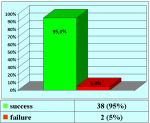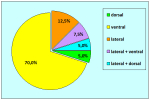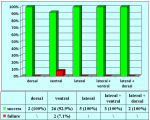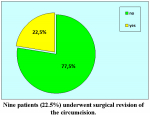In 1965, American Urologist Reed N. Nesbit, from Michigan University, first described three cases of young patients with penile curvature during erection. Nesbit reported that the curvature in these cases was caused entirely by an asymmetry of dimension in the corpora cavernosa, and a comprehensive search of the literature has yielded no previous references to this congenital deformity. Nesbit also present the description of corrective operation. After the Nesbit’s report, numerous articles have been published in the literature and the surgical technique described by Nesbit in 1965 was accepted as the gold standard technique for the correction of this asymmetry of dimension in the corpora cavernosa.
Penile curvature caused by an asymmetry of dimension in the corpora cavernosa is a congenital deformity of penis. The curvature is fully evident after the post-pubertal genitalia development when the penis increases in length. The aetiology of this congenital anomaly is not fully investigated.
The deformity appeared to be due solely to a disparity in length between the upper convex surface and the lower concave surface of the corpora cavernosa. For this reason the full erection of the penis cause a downward penile curvature, because the short lower concave surface of the corpora cavernosa don’t expand as the upper convex surface. In the majority of patients the congenital penile curvature is a downward curvature, but in few patients the curvature is lateral.
The surgical technique is based on the shortening the longer upper convex surface of the corpora cavernosa, thus restoring the length between the upper convex surface and the lower concave surface of the corpora cavernosa. This technique causes a 1-2 cm shortening of the penis. In some patients the penile congenital curvature may be associated with penile torsion or combined curvatures (downward plus lateral). Surgical correction of these complex congenital curvatures represents a challenging problem and should be referral to a specialized Center.
Penile curvature caused by an asymmetry of dimension in the corpora cavernosa is a congenital deformity of penis. The curvature is fully evident after the post-pubertal genitalia development when the penis increases in length. The aetiology of this congenital anomaly is not fully investigated.
The deformity appeared to be due solely to a disparity in length between the upper convex surface and the lower concave surface of the corpora cavernosa. For this reason the full erection of the penis cause a downward penile curvature, because the short lower concave surface of the corpora cavernosa don’t expand as the upper convex surface. In the majority of patients the congenital penile curvature is a downward curvature, but in few patients the curvature is lateral.
The surgical technique is based on the shortening the longer upper convex surface of the corpora cavernosa, thus restoring the length between the upper convex surface and the lower concave surface of the corpora cavernosa. This technique causes a 1-2 cm shortening of the penis. In some patients the penile congenital curvature may be associated with penile torsion or combined curvatures (downward plus lateral). Surgical correction of these complex congenital curvatures represents a challenging problem and should be referral to a specialized Center.
1. Question: Is the surgical procedure fully covered by the National Health Care System?
Answer: Yes.
2. Question: What kind of anesthesia is used for this surgery?
Answer: General anesthesia with oro-tracheal intubationt.
3. Question: How many hours does the surgery take?
Answer: About one hour.
4. Question: Are there any risks concerning erection after the surgery?
Answer: No, there aren’t.
5. Question: How many days of hospital recovery are expected following the surgery?
Answer: In general, from 2 to 4 days.
6. Question: How long will I have to use a urethral catheter following surgery?
Answer: The urethral catheter must stay in place for 48 hours following surgery.
7. Question: Are there any particular recommendations during convalescence?
Answer: During convalescence, antibiotic use is suggested until the catheter is removed. It is also suggested that sexual activity be avoided.
8. Question: When will I be able to resume sexual activity?
Answer: Sexual activity can be gradually resumed one month after surgery.
9. Question: Can I ride a bike or a motorcycle immediately after the surgery?
Answer: Yes.
10. Question: What kinds of foods and drinks should be avoided after the surgery?
Answer: None.
Answer: Yes.
2. Question: What kind of anesthesia is used for this surgery?
Answer: General anesthesia with oro-tracheal intubationt.
3. Question: How many hours does the surgery take?
Answer: About one hour.
4. Question: Are there any risks concerning erection after the surgery?
Answer: No, there aren’t.
5. Question: How many days of hospital recovery are expected following the surgery?
Answer: In general, from 2 to 4 days.
6. Question: How long will I have to use a urethral catheter following surgery?
Answer: The urethral catheter must stay in place for 48 hours following surgery.
7. Question: Are there any particular recommendations during convalescence?
Answer: During convalescence, antibiotic use is suggested until the catheter is removed. It is also suggested that sexual activity be avoided.
8. Question: When will I be able to resume sexual activity?
Answer: Sexual activity can be gradually resumed one month after surgery.
9. Question: Can I ride a bike or a motorcycle immediately after the surgery?
Answer: Yes.
10. Question: What kinds of foods and drinks should be avoided after the surgery?
Answer: None.
| Up-to-date to 12-31-2013 | |||

Summarizing table |
|||






